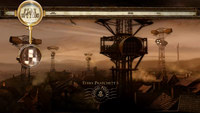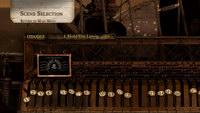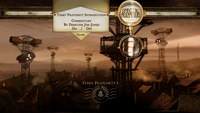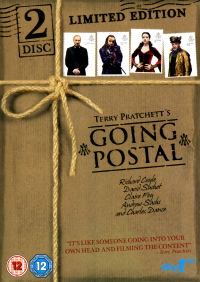
20.9.2010 #490
English Version 3.6.2013
by Guido Bibra
• Director's Audio Commentary
• Director & Producer Interview
• Terry Pratchett Interview
• Cast Interviews
• Bloopers
• Costume and Make-up Featurettes
• Interview with the Fans
• Image Galleries
![]() The Movie
The Movie
Moist von Lipwig is one of the many crooks, fraudsters and forgers on the Discworld - but one of the best. This saves his neck when he is caught in Ankh-Morpork and hanged - to his astonishment Lipwigs next appointment is not with a man wielding a scythe, but with Lord Vetinari, the Patrician of the city. He recognizes Lipwigs talents and gives him one chance to keep his execution from going forward: employing his special talents to revive the run-down post office of the city.
Terry Pratchett's Discworld has always been in a constant state of evolution, because especially in his newer stories the author had developed his fantasy world further and transformed it from a medieval scenery into a victorian age. Belonging to this are a series of stories around Ankh-Morpork, the biggest city on the Discworld, telling about an industrial revolution, which apart from a thriving newspaper industry also results in a telegraph service based on signal towers. But the postoffice of the city had already been mentioned as having completely collapsed in earlier stories, prompting Terry Pratchett in 2005 to tell its past and future story in a new book.
Similar to the 25th Discworld novel The Truth, a story about newspapers in Ankh-Morpork, Going Postal again introduced a completely new main character - something that had actually not happened very often in Terry Pratchett's novels before. Thanks to the familiar scenery and secondary characters this was not a completely new start, but it brought a fresh wind into the Discworld. The plot was also far away from classic fantasy, because instead of wizards, witches and magic the themes were much more real with signal telegraphy, mail, economic competition and marketing - it almost did not mattter that the story happens on a flat world standing on the back of four giant elephants riding through space on a giant turtle.
Especially because it was so down-to-earth, the story of Going Postal was ideally suited for a third Discworld live-action adaptation after Hogfather and The Colour of Magic, which had both been produced by the filmmaker group The Mob for SkyOne. Now Vadim Jean, the director and writer of the first two three-hour-movies had left to become only an executive producer, turning Going Postal over to a new team of filmmakers. The movie was part of a multi-million pound investment initiative of SkyOne into literature adaptions, making a very generous budget possible.
For the script adaptation of Terry Pratchett's novel, the team of Richard Kurti and Bev Doyle, better known as just Kurti & Doyle were found. The two authors had started their career in british independent cinema and had a two-year development contract with Miramax, which unfortunately did not result in any movies. But they were more successful in the British television industry and had written scripts for the series of Robin Hood and Primeval, before they worked on the BBC two-parter Sherlock Holmes and the Baker Street Irregulars. It must have been this sense for victorian sceneries which led The Mob to hire them as external scriptwriters. Jon Jones, who had directed a lot of high-carat British television productions before, also became a new member of the team.
Terry Pratchett's multi-layered, complex novel could never have been adapted in its entirety as a two-part, three-hour movie, unless Going Postal was filmed as a multi-episode series, which was not the concept of Sky for its program of literature adaptions. While Hogfather stayed mostly true to the original, the next movie The Colour of Magic had made a lot of changes to the two source novels. This actually didn't seem necessary with Going Postal because of the relatively straight story, but Kurti & Doyle did not only streamline the story. The plot was heavily rewritten and characters were removed and simplified - the result was still unmistakably one of Terry Pratchett's Discworld stories, but more an alternative version of Going Postal than a direct adaptation.
The omissions are understandable because the many small and even larger subplots about a golem thousands of years old, Mr. Groats strange hygienic beliefs, the postoffice cat, the intrigues around the clacks company and a magic letter sorting machine would only have hindered the story too much. More peculiar was the decision of the filmmakers to add a lot to the plot which had not been present in the novel. The love story of Moist von Lipwig and Adorabelle Dearhart was unnecessarily thrust into the foreground, something especially untypical for Terry Pratchett. The competition between the clacks and the postoffice was also more heavily featured, but this actually became an advantage for the film adaptation and made full use of the fascinating world of signal telegraphy.
Also, some of the characters were not really consistent with the novel. In Terry Pratchett's original story, Moist von Lipwig is a cunning fraudster, who mainly has fun with his scams and is not easily baffled, but in the adaptation he is more of a money-hungry crook and much more nervous. Reacher Gilt as the pirate-like main antagonist was made even more dangerous and brutal, in his movie incarnation he does not even shy from murder by his own hands. The clacks empire was shrunk down to only three people: Reacher Gilt himself, Crispin Horsefry, who was transformed from a rich snotty weasel to a fat accountant and the engineer Mr. Pony, who only has some short guest scenes.
While the certainly not bad, but heavily changed script may be somewhat disappointing for viewers who have read the original, the brilliant casting made up for it and did not rely solely on star power, but on a very carefully chosen group of actors.
For the main character of the gentleman crook Moist von Lipwig the filmmakers were able to get the british actor Richard Coyle, who was so busy that he was barely able to find time for Going Postal. Before he had played a secondary role in the Hollywood blockbuster Prince of Persia, but he was also famous in British television through his appearances in the sitcom Coupling and the mystery series Strange. Because Richard Coyle had been on the way to Hollywood, his return to the British television screens was all the more surprising. Apart from the script-related changes, the actor actually played his character astonishingly close to the novel and was the ideal casting for the charming and crafty crook with a lot of showmanship.
The female lead had been somewhat expanded from the novel and was cast with the classically trained British stage actress Claire Foy, who before had only rarely acted in front of a camera. The filmmakers had discovered her in the BBC miniseries adaptation of Charles Dickens' Little Dorrit and were able to interest her in the role of Adorabelle Dearhart, the Golem organizer with a past in the clacks business. With Little Dorrit, the young actress had already gathered some experience with victorian sceneries and strong female characters, making her the ideal choice for her role in Going Postal. Her character was made somewhat more dramatic and emotional and was not as cold and calculating as in the book, but the actress makes the most of her appearance and is actually a wonderful opponent for Richard Coyle.
The casting of the postmen was also brilliantly done, because the filmmakers did not succumb to the temptation of getting David Jason again for the role of Junior Postman Groat. Instead, this crucial character was given to the wonderful Andrew Sachs, who first became famous for his role as Manuel, the long-suffering Spanish waiter in John Cleese's Sitcom Fawlty Towers, but had since transformed into a versatile character actor. In Going Postal he returned to his comedy roots and, despite all the script changes, he was able to play the crusty postman essentially like Terry Pratchett had described him in the book. As Groat's peculiar sidekick Stanley, the filmmakers chose the stage, television and sometimes cinema actor Ian Bonar, who was able to infuse his character with a careful amount of innocent madness.
Amazing was also the filmmaker's choice for Reacher Gilt, the pirate-like antagonist of the story, whose role was more expanded from the novel and seemed an even more dangerous and nasty adversary to Moist von Lipwig. None other than the great David Suchet was chosen, who had in his decades-spanning career played many roles, but his most famous one was the definitive incarnation of Agatha Christies master detective Hercule Poirot in the ITV television series, making him almost overqualified for Going Postal. Nevertheless Suchet made a magnificent figure as a sort of schizophrenic psychopath ranging from slimy businessman to crazy murderer. At his side is the indian-british actor Madhav Sharma as Gilt's nervous and clueless accountant Crispin Horsefry, whose character actually has nothing to do with the original novel - he was created as a kind of bumbling sidekick.
Another potential problem was the casting of Lord Vetinati, the Patrician of Ankh-Morpork - an important figure from the Discworld canon, of which many fans had special expectations. In The Colour of Magic, the role had been given to Jeremy Irons in a short guest appearance, but it was not altogether clear if this was meant to be Vetinari or one of his more mad predecessors. The choice for Going Postal was surprising and on first glance completely wrong, but on closer inspection turns out to be a stroke of brilliance: the british character actor Charles Dance does indeed have the completely wrong hair colour, but manages to play Vetinari in his few, but crucial scenes so perfectly that he does more than justice to Terry Pratchett`s original character. Drumknott, the Patrician's clerk also appearing in many stories, was expertedly played with a wonderfully nasty friendlyness by Steve Pemberton, a member of the comedy group The League of Gentlemen. And, of course, there's a small appearance by Terry Pratchett himself at the end of the second part.
The many other secondary characters were also perfectly cast. The golem Mr. Pump was actually played by two different actors: the costume was inhabited by the dutch acrobat and dancer Marnix van der Broeke, who had played Death in the previous film adaptations and managed to bring the Golem in exactly the same fascinating way to life. The sonorous voice of the clay gentleman was, however, provided by the very busy british actor Nicholas Farrell, who did not need much digital manipulation to really sound like hollow pottery. Archchancellor Ridcully only has a small appearance, for which his previous actor Josh Ackland could not be cast, but his substitute Timothy West was doing a very fine job. John Henshaw as the clacks engineer Mr. Pony had unfortunately only little screen time, as had Jimmy Yuill as the printer Mr. Spools. The journalist Miss Cripslock, actually a character from the previous novel The Truth, also made only a short appearance played wonderfully by Tasmin Greig - perhaps an indicator for a future film adaptation.
While the adaptation of Going Postal may not be really true to the original in the script, the visual design was amazingly spot on. The movie was shot entirely on location and in studios in Budapest - not especially because it was cheaper, but because the historic inner city of the Hungarian capital was a perfect representation of Ankh-Morpork. The atmosphere of a former medieval city in the middle of an victorian industrial revolution resembling London of the late 19th century was brilliantly achieved - this was especially crucial because almost the whole plot plays out in Ankh-Morpork. The decision to base the production in Budapest was exactly right and made a completely natural and realistic background scenery possible.
Of course not everything could be filmed in Hungary, because turning Budapest into Ankh-Morpork involved a lot of digital visual effects of all sorts, which were provided by the two Hungarian companies Filmefex Studios and Digital Apes. Especially remarkable was the visualization of the clacks towers, which were a combination of CGI, models and life-size sets. Although the signal towers. originally a combination of paddle and light signals in the novel, had been somewhat modernised, they were a surprisingly plausible and realistic system of communications. Also astonishingly simple, but very effectively solved was the problem of the golems: a complete CGI animation would have been much too expensive, but the filmmakers had found a Hungarian company able to manufacture realistic-looking costumes, which came astonishingly close to Terry Pratchett's original descriptions of the clay men.
For the musical accompaniment the filmmakers did not call on David A. Hughes again, who had written the scores of Hogfather and The Colour of Magic - instead they hired his colleague John Lunn, another very busy composer, who had worked on more than sixty mostly British television series and movies. What could have been a 08/15 assembly belt score became a surprisingly versatile and very suitable film music. Especially the main theme, which was not as heavily overused as in The Colour of Magic, provides a brilliantly catchy tune in the quirky and almost nostalgic style of Henry Mancini, while the rhythms also remind a little of Danny Elfman's earlier works. Overall, the score is very melodious, playful and sometimes a little bit melodramatic, but always perfect for the plot.
Going Postal may be at first glance somewhat disappointing due to the changes from book to screenplay, but the terrific actors, the gorgeous visuals and the faithful atmosphere nevertheless make this movie a successfull adaptation. It is more an alternative version of the story than a complete dramatisation, which would not have been possible in a two-part, three-hour film. In spite of the liberties taken by the filmmakers, Terry Pratchett's comment "It's like someone going into your own head and filming the content" is still more than valid and not only a hollow merchandising promise.
The movie was premiered in May 2010 on Sky One after a thorough and clever marketing campaign, which was once again mainly focused on the internet. Reviewers and fans were delighted and while the changes to the book's original story were one of the few things criticised, the overall response was very positive. As usual, the movie failed to impress much outside of Europe because of the very specific British humour - there has been no report of an American television airing, but it was shown in dubbed versions in many European countries including Germany and there have been DVD and Blu-Ray releases not only in England.
![]() The DVD
The DVD
After the British television broadcast on the pay-tv channel Sky One in May 2010 Going Postal had been released on DVD and Blu-Ray in England only three months later. The release date had been announced even before the broascast, so the movie was pratically also a direct-to-video release. While the DVD of the predecessor The Colour of Magic was missing some essential extras of the parallel Blu-Ray release, 20th Century Fox had not made the same disappointing error with Going Postal and included almost everything on the DVD.
There was only one Blu-Ray edition, but the DVD was released as a single disc and a 2-disc limited edition, which was worth the small additional price. Unfortunately, this version is now out of print in England with only the 1-disc release available, but the German 2-disc release from KSM contains all the extras from the UK release. The British Blu-Ray is still available, but there is also a matching German release.
The DVD reviewed in this article is the British 2-disc limited edition, which is more than satisfactory and one of the best Discworld DVD releases so far. Although not released in a digipack, this DVD came in a transparent Amaray keepcase in a beautifully designed carton slipcover. It did not come with a booklet, but as a special gift a collector's edition of four exclusive Discworld stamps printed by The Discworld Emporium was included.
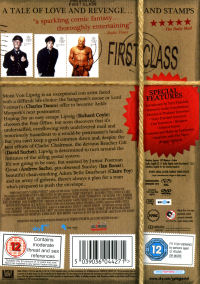
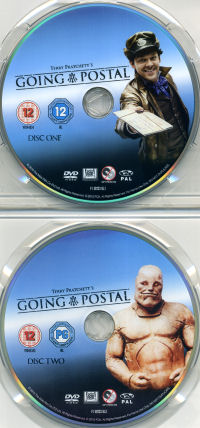
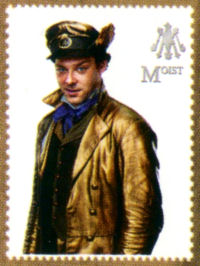

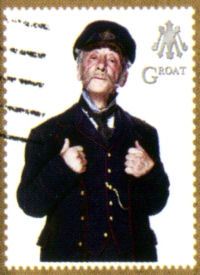
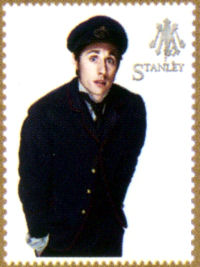
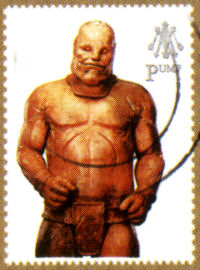
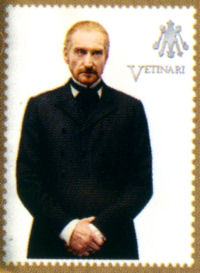
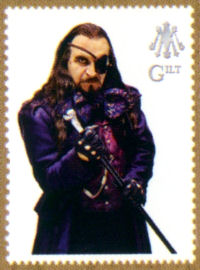

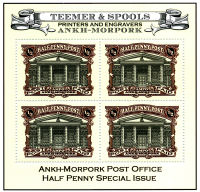
![]() Image
Image
In 2006, Hogfather had been one of the very first British television production which were completely shot with HDTV cameras. Four years later this was completely normal and Going Postal was again shot with the special digital cameras from Arri. The DVD version was directly converted from the HD master into the anamorphic PAL resolution and leaves the impression of being practically perfect - only on closer inspection a few imperfections can be noticed.
The image provides excellent detail without being overly sharp - no additional sharpening filter has been applied, so the DVD looks very natural and filmlike. The colours have been somewhat modified by digital grading from almost monochrome to a very extended colourful spectrum - everything is perfectly reproduced and almost leaps from the screen. Despite the generally very good look of the DVD, there is a distinctly visible amount of digital noise in many of the dark scenes present, which seems to come from the digital film cameras and almost, but not entirely looks like film grain.
The authoring of the DVD is, however, very well done, especially considering that both episodes of the film with a runtime of over three hours have been put on one dual-layer disc. A very dynamic bitrate, hovering at about 5 mbit/s, but sometimes reaching up to 8 mbit/s, makes sure that there are almost no compression artifacts. Apart from the problems with the digital noise, this DVD delivers a brilliant quality which still looks good even on larger screens.
![]() Sound
Sound
Going Postal had already been mixed in 5.1 for the television broadcast and this is the soundtrack provided on this DVD - in addition there's a stereo-surround track with an audio description.
The English 5.1 soundtrack has been encoded in Dolby Digital with the maximum of 448 kbit/s and is technically flawless. It sounds very fresh and transparent with a deep bass and solid trebles, like it can be expected from a modern digital production. The mix itself is, however, surprisingly conventional and almost makes the impression of a tame stereo soundtrack. The music is, apart from a faint echo on the surround channels, almost entirely confined to the frontal soundstage. The mix is actually so narrow that dialogue and music are almost entirely confined to the center channel. If it wasn't for the very active sound effects, which are using all five channels, this might have been almost a mono upmix.
The second soundtrack is a well-made audiodescription for visually impaired viewers, which had already been produced for the television broadcast and is almost like a radio play. It is only coded in 2.0 surround, but due to the front-heavyness of the 5.1-track this is not very noticeable. English subtitles are provided, but only for the main movie and not the extras.
![]() Extras
Extras
The bonus materials of the British 2-disc-release are nearly identical to the Blu-Ray and do not contain an extensive documentary, but instead a very good audio commentary, lots of interviews and much more. Even the menu design with its retro-look is very successful.
The Audio Commentary by director Jon Jones is very extensive and contains an immense amount of information about the making of the film and its conception. Talking almost three hours continuously, he has a lot to say about almost every moment of the movie - from funny anecdotes, much praise for the actors and the crew to detailed background information. Jones is not always scene specific, but very entertaining and a good narrator with a great knowledge about Terry Pratchett and the Discworld. He even explains about the many changes made to the original novel, which makes understanding the way the script was written much more easier.
The Terry Pratchett Introduction (4:44) is a short and charming introduction by the author.
All further extras are located on the second DVD.
The Interviews are altogether 50 minutes long and were originally shot for promotion purposes during the making of the movie, but are much more than just advertisement and almost a whole documentary.
• Terry Pratchett (5:10)
• Director & Producer (5:44)
• Cast - Richard Coyle, Claire Foy, Charles Dance, David Suchet, Andrew Sachs, Ian Bonar, Steve Pemberton, Madhav Sharma, Timothy West (27:47)
• Costumes - Charlotte Holdich (7:44)
• Makeup - Lesley Lamont-Fisher (2:06)
• The Fans (2:52)
The Image Gallery shows as short film clips 56 storyboards (4:39), 21 props - actually printed material shown in the movie (1:49) and 6 set drawings (0:29).
The Deleted Scenes are relatively short and do not contain any material very important to the plot, but it is good to see what has been removed from the final cut of the movie.
• Dave's Pins (Longer Version) (2:35)
• Princess and Rogers Clacks Tower (0:46)
• Lipwig bribes Mr. Spools (0:57)
• Gilt and Horsefry, Snake Sheds its Skin (1:05)
• Coach has been attacked (0:12)
• Lipwig finds out about Lodgers (0:44)
The Bloopers (3:53) are a short, but funny collection of outtakes, showing how much fun the actors had during the shooting.
